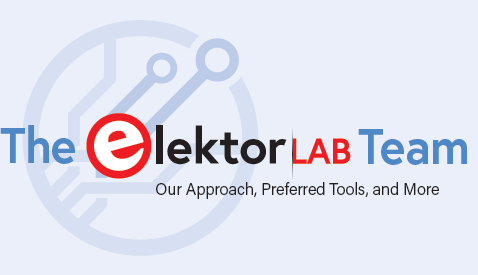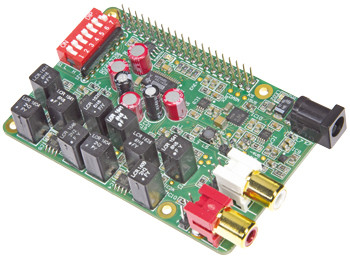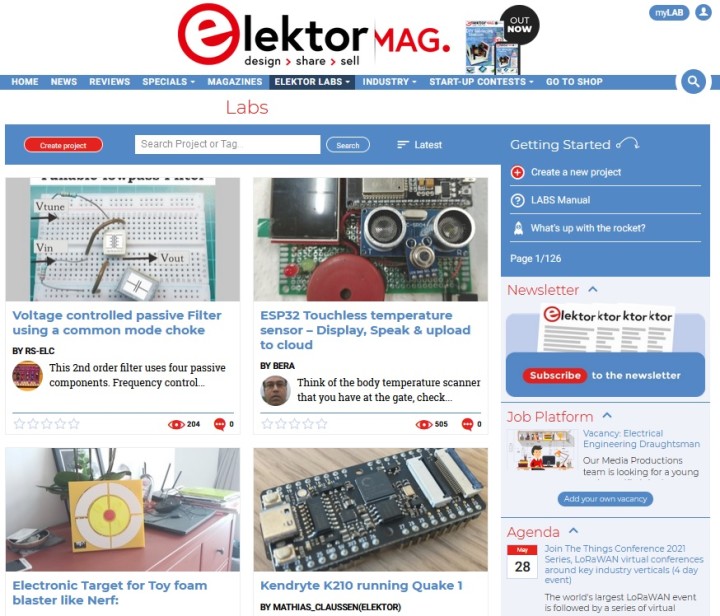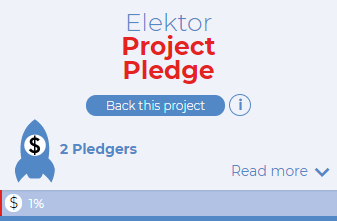The Elektor Lab Team
on

For six decades, Elektor magazine has featured a healthy mixture of theory and practice. It is in our DNA. It all started more than 60 years ago with electronics enthusiast Bob van der Horst who was bored by dry datasheets and theoretical articles full of formulas and diagrams. Instead, he wanted to publish a magazine with circuits that readers could build and modify. From those early days, most of the circuits and projects were built and tested before they were published in Elektor magazine. And as a result, the Elektor Lab quickly became famous. The work of the Elektor Lab continues to this day. Curious about the status of the Elektor Lab in 2022? Read on and join us!
What Is the Elektor Lab?
The Elektor Lab is both a location and a team. Each Elektor Lab member has a home electronics workbench for soldering, reverse engineering, programming, and tinkering. Elektor also maintains a useable electronics workspace in its HQ that is stocked with handy lab equipment, components, and engineering tools. Lab team members can pop into the workspace at any time to test designs or collaborate on projects.
The actual team comprises engineers of various ages, backgrounds, and personalities. From the very beginning, the Lab has included analog guys interested fiddling around for months on big circuits as well as programming enthusiasts interested contributing fresh ideas. To put it simply, we have a diverse crew.

Some magazines only report about kits or new products. Not Elektor! We do much more. We have always endeavored to uncover all the details of a project, including the source code, whether it was a new project from one of our engineers or it was from an enthusiastic reader’s home lab. Why has this been Elektor’s approach? Our reasoning is clear. We want our readers to be able to build the same projects, and we invite them to modify, improve, and expand everything we publish. Whether you are a professional engineer or a weekend maker, we want you to understand how everything works. So, it is not an overstatement to say that Elektor has been one of the long-time leaders in the open-source movement!
Most Elektor readers and community members will also recognize that there is no strict line between our Lab engineers and editorial team. All the engineers in the Lab (Clemens Valens, Luc Lemmens, Mathias Claussen, and Ton Giesberts) are writing articles, and all the editors including me and Content Director C. J. Abate also have fun contributing ideas and input to Lab projects.
As we kick off a new year, we encourage everyone to get to know the Elektor Lab team. On these pages, you will find a short presentation about the Elektor Lab team members and some of the platforms and tools that we use. We invite you to contribute your ideas, feedback, projects, and articles!
The Elektor Lab Team
Clemens Valens is an engineer who manages the Elektor Labs online platform. He holds a BSc in Electronics and an MSc in Electronics and Information Technology. Clemens started working for Elektor in 2008 as Editor in Chief of Elektor France, and he has also worked as an editor for Elektor UK/US and ElektorMagazine.com. Later, Clemens was head of Elektor’s design labs in the Netherlands, Germany, and India. Today, he is Elektor’s creative technologist responsible for the Elektor Labs community website where electronics enthusiasts can publish their work and interact with peers from all over the world. Besides contributing own projects and other articles to the magazine, he is also producing regular videos for Elektor TV and moderating webinars. His main interests are sound generation and signal processing.
Mathias Claußen started as a trained IT systems electronics technician and earned a BSc in Electrical and Information Engineering and a MSc in Microelectronic Systems. After this, he worked as a project engineer for embedded development and focused on ARM Cortex-M-based architectures and real-time operating systems. Mathias joined Elektor in 2018 as part of the Elektor Lab team focusing mainly on software. Today, it is more than just software development in the background. Mathias writes articles about hardware and software development, creates videos for Elektor TV, and more. Want to learn about his home workspace? You can read about it online at Elektor. You can see some of the instruments and tools Mathias is using for many daily tasks there.
Luc Lemmens started working for Elektor in March 1990 after his studies at the Technical University Eindhoven. At the time, he also published Elex, an electronics magazine aimed primarily at the novice electronics hobbyist. Luc designed and edited projects for both magazines. He has many interests, which means that he knows a little about a lot of topics in electronics. Of course, he has also written or edited software in a wide range of programming languages — and, especially in his early days at Elektor, in assembly language. Nowadays, he usually limits himself to the Arduino IDE, which is perfect for most simple projects. Over the years, Luc has also written and translated technical text and even Elektor books. In his spare time, Luc likes to play with pinball machines, especially repairing and restoring both modern electronic machines and electromechanical ones (with relays and stepper units).
Ton Giesberts started working at Elektuur (now called Elektor) after his studies when they looked for someone with an affinity for audio. Over the years, he has worked mainly on audio projects. Analog design has always been his preference. Of course, projects in other fields of electronics are part of the job. One of Ton’s mottos is: “If you want to have it done better, do it yourself.” For example, a PCB design: for an audio project with distortion figures on the order of 0.001%, a good layout is crucial!
Recent Elektor Lab Projects and Products
The Elektor Lab team has prepared many electronics projects for Elektor. Sometimes a design is developed entirely by the Elektor Lab. Other times, our Lab team members adapt projects from external designers. And sometimes ideas are outsourced for collaboration with our partners. The end result might be an article (or article series) or product that is sold in the Elektor Store. Below is a list of just a few successful Elektor Lab projects from recent years.

- Clocks: Electronic clocks have always been popular with the readers of Elektor magazine. Also because they are the devices par excellence to give old displays a new application, as in the 6-digit Nixie Clock and the Pinball Clock.
- Weather Station with ESP32: Buy an affordable, complete set of weather station sensors and add state-of-the-art electronics and software to build your own weather station.
- Audio DAC for Raspberry Pi: Raspberry Pi boards have audio outputs, but if you want real high-quality sound, an external high-end Digital-Analog-Converter is needed, like this board designed by our audio wizard Ton Giesberts.
- DIY LiPo Supercharger Kit: Need a rechargeable LiPo power supply kit for 5 V and 12 V output? Check out the kit the Elektor Lab developed in cooperation with GreatScott!
- New LCR Meter 50 Hz - 2 MHz: The LCR Meter 50 Hz - 2 MHz is a high-precision device for testing and measuring passive components. It can compete with — and even beat! — commercially available equipment.
- Book: Mastering Microcontrollers Helped by Arduino: Clemens Valens’s book, Mastering Microcontrollers Helped by Arduino, will familiarize you with the world of Arduino and you will learn how to program microcontrollers in general. Some of the proposed projects include a car GPS scrambler, a weather station, an infrared remote manipulator, and PID controller.

Elektor Labs Platform
The Elektor Labs online platform was developed for engineers, makers, and students who are passionate about electronics. It is a place where you can share your projects, participate in those posted by others, and discuss project development and electronics. Elektor Labs is open to everyone; the only requirement is a free Elektor ID. Now in its tenth year, Elektor Labs has gathered more than 10,000 active users who have posted more than 2,000 projects and countless comments.
Elektor Jumpstarter
Elektor Jumpstarter is Elektor's take on crowdfunding. The online platform is intended to help innovators like you turn your electronics projects into products. To apply, simply post a project at Elektor Labs and then click the Jumpstarter button. It will then be evaluated by Elektor. When a project is accepted, the community can start backing it.Backing a project does not involve any money. Instead, when someone “backs” a project, it indicates their interest in having the chance to purchase the final product if the Jumpstarter campaign reaches its goal (i.e., a certain production quantity at a predefined price). If the campaign succeeds, Elektor will produce the product and put it in the Store for anyone to buy.

In short, at Elektor Labs, our motto Design, Share, Sell really comes to life. Read more about Elektor Jumpstarter.
The Tools We Use
Curious about the tools and solutions we use on a regular basis? Here is an overview of some the essentials. Let us know what you use in the comments section below this article.- Open-Source Design Tool: KiCad — Elektor loves open-source solutions, so the Elektor Lab team members tend to use open-source tools. One example is KiCad, which we use (besides Altium and Eagle) to design schematics and PCBs. KiCad is free to use, open-source and runs on all three major operating system. This enables you to share your work with others so that they can also adapt or modify your creation as needed. You can find online articles and videos about KiCad at the Elektor site: www.elektormagazine.com/tags/kicad
- Elektor PCBs — Elektor readers are used to finding green drawings of (mostly small) PCBs in the magazine. As a service for many years, almost all these PCBs were available in our Store for people who wanted to find and solder the components themselves. From most of these naked PCBs, we only sold a few pieces, and these figures have even decreased in the last years. We have to face the fact that the electronics world is changing. It makes no sense to develop a microcontroller or a small audio amplifier board (just to name two examples) from scratch and produce it in small quantities for (too) high prices. Today, makers and professionals alike are used (and are even expecting) to getting inexpensive modules with at least the most important components — as SMD blocking capacitors or pull-up resistors — already integrated. Time is money, so most electronic developers want out-of-the-box prototyping solutions. They expect to open the box, connect everything, and start working. However, this doesn't mean that we do not sell any PCBs or kits anymore! We focus on the most promising and interesting projects, where we really invented something original which can’t be ordered for a few bucks everywhere. For these projects, we have set up collaborations with partners who are experienced at producing small and also larger quantities when needed. Two of these partners are Eurocircuits and SIMAC (Joy-IT). If a small board is needed but is not available via an Elektor-partner collaboration, we will offer the CAD files for free. Each reader can adapt the PCB or use it as it is, and order it via a PCB production service. We recommend www.elektorpcbservice.com, which we offer in cooperation with our partner Eurocircuits.
- Elektor @ GitHub — The Elektor Lab uses the Elektor Labs platform to host its own projects and projects from external authors. You will find the files (software and hardware) required for the projects there. For larger projects that are continuously developed, managing the different versions can become confusing. This is where GitHub comes in, which brings a version management system so you can easily revert to a specific state or track changes made. GitHub also offers several other advantages, such as experimental alternate versions, issue trackers for suggestions and comments, or community-supplied patches in the form of pull requests. Therefore, we will offer more and more software and also CAD data for download on GitHub (https://github.com/ElektorLabs). The corresponding web link can be found at the end of each project article. For GitHub beginners, Clemens Valens from the Elektor Lab has created a video tutorial at on Elektor TV, which you can see below.
Follow Us on Social Media
Elektor Lab members and editors are easily accessible on social media. Feel free to follow us and reach out on Twitter, Facebook, and YouTube.
- Twitter: Mathias Claussen: https://twitter.com/elektormathias
- Twitter: Clemens Valens: https://twitter.com/clemens_elektor
- Twitter: Elektor: https://twitter.com/Elektor
- Twitter: C. J. Abate: https://twitter.com/elektor_us
- YouTube (ElektorTV): https://www.youtube.com/user/ElektorIM
- Facebook: Elektor Labs: https://www.facebook.com/ElektorLabs/
- Instagram: Elektor Labs: https://www.instagram.com/elektorlabs
Elektor Needs You!
In contrast to a lot of other magazines, articles and other interesting content does not flow one-way from Elektor to you. It also goes the other way around. We encourage our growing worldwide community of engineers and makers to contribute ideas, tutorials, tips and tricks, circuits and projects.
Can you teach others about a certain subdomain of electronics or software? Have you developed a nice electronics project? Do you have special area of technical expertise? Our readers may be very interested in that. There are 2 ways to share tips, tutorials and projects:
- You post something on Elektor Labs. Here you can immediately get in touch with other readers, maybe on the other side of the globe, to get positive and critical feedback! You also have the chance to get backers for your project. On the Elektor Labs platform, ideas and questions are welcome!
- You can send your article/project to the editorial team by mail: editor@elektor.com. You don't have to have a ready-made article text, but a circuit diagram and a short description is a must to let us know what you have in the works. Of course, we will not uncover any details of your project without your ok!
Elektor editors and Lab team members review all the contributions during our weekly internal meetings. If we select your article to be published in print or online, we will let you know, and we will discuss the next steps with you.


Discussion (0 comments)